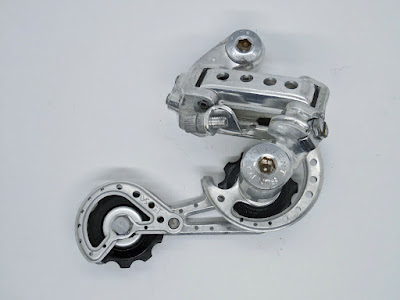Racers and cycling's trendistas (who generally spend more than they ride) have long been obsessed with having the lightest bikes and equipment possible because they've bought into the notion that lighter=faster. Now, it's true that a lighter bike is easier to accelerate, all other things being equal. However, once a bike reaches a given speed, a heavier bike will maintain its speed with less input from the rider: This phenomenon is known as momentum. But it will also decelerate at a faster rate because of headwinds or other factors.
Anyway, during the 1970s and early 1980s, the obsession with weight led to a fad called "drillium." It's what it sounds like: holes were drilled (or slots were cut) into parts to reduce weight. In most cases, the mass saved--a couple of grams, usually--wouldn't make any difference for any rider save perhaps a time trialist.
Interestingly, track riders--whom one would expect to be most obsessed with weight-- don't seem to have embraced the "holey" look as much as other riders. did. If I'm not mistaken, NJS, the governing body for Japan's Keirin racing system, prohibits the practice. And when some companies offered pre-drilled or -slotted parts--like Campagnolo's brake levers--they were actually heavier, if ever so slightly, than their smooth-surfaced counterparts. The reason, I was told by a company rep, is that the Campy used slightly thicker material to compensate for what they believed was a loss of strength that resulted from drilling or slotting.
That leads me to another point about "drillium:" the parts that were drilled or slotted were usually among the lightest to begin with. As an example, I've seen Huret Jubilee derailleurs--to this day, the lightest made--with pinpoint apertures in it pulley cages. And the poked and gouged parts were almost always intended for racing.
So, I was surprised (even if I shouldn't have been) to come across this:
Now, the SunTour Vx-GT wasn't porky: Even by today's standards, it's more than reasonably light for a rear derailleur that can handle a 34 tooth rear cog. (And, it shifted better than almost any other wide-range derailleur made before indexed shifting became the standard.) But that capacity is the main reason why racers and others who rode with narrow-range gearing didn't use it: If they rode a derailleur from the Vx series, they used the shorter-caged version.
So...I guess someone thought he or she simply had to save weight on the rear derailleur to make up for something he or she carried in a pannier or handlebar bag. It reminds me of someone I knew who made floats with Haagen-Dazs ice cream--and Diet Coke: the lack of calories in the latter, she said, balanced out the abundance of same in the former.

































